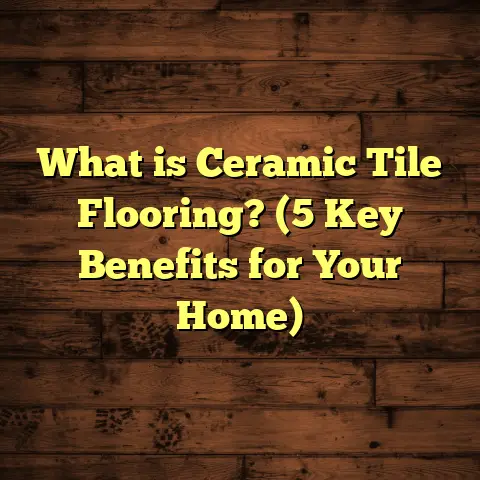What is Flooring in Construction? (5 Types Every Builder Needs)
I want to share with you something that many builders and homeowners overlook
but can make a huge difference in the success of a construction project:
flooring. It’s often the best-kept secret in construction — a detail that,
when done right, can elevate the entire space but when overlooked, causes
major headaches later on. Over my years working on countless flooring jobs,
I’ve gathered insights and stories that reveal why flooring deserves more
attention than it usually gets.
Flooring: The Foundation You Walk On
Think about the last time you walked into a house or office and immediately
felt comfortable or wowed. Chances are, the floor had a lot to do with that
feeling. Flooring isn’t just about covering the ground; it’s about creating
a base for everything else, both functionally and aesthetically.
When I started out, I used to focus heavily on walls, ceilings, and
fixtures — flooring was just something that got installed and forgotten. But
after a few projects where flooring issues caused delays or unhappy clients,
I realized how much the choice and quality of flooring impact the whole build.
My Experience with Different Flooring Types
Over the years, I’ve worked with a variety of flooring materials, each with
their own quirks and strengths. Here are five types every builder — or even
a savvy homeowner — should know well:
1. Solid Hardwood Flooring: The Classic Workhorse
Hardwood floors have been around forever and for good reason. When done right,
they last decades — sometimes over a century — and can be refinished multiple times.
What I’ve learned:
- Hardwood is strong but sensitive to moisture. You’ll want to avoid installing it in basements or bathrooms unless it’s properly treated.
- The installation can take time because wood expands and contracts with humidity changes.
- Costs vary a lot based on wood species — oak and maple are popular mid-range options, while exotic woods like Brazilian cherry can double or triple your budget.
Data point: According to the National Wood Flooring Association, hardwood floors can increase a home’s resale value by up to 2.5%. That’s not just beauty — it’s an investment.
In one project I handled, a client chose white oak for their living room. We had to carefully acclimate the wood planks for two weeks before installation. This prevented warping and gaps later on. It cost a bit more upfront but the durability was worth it.
Installation Nuances
Installing solid hardwood is an art in itself. One thing I always stress is proper subfloor preparation. Any unevenness can cause squeaks or premature wear. I’ve seen projects where ignoring this led to costly callbacks.
Nailing down hardwood requires skill to avoid splitting boards or uneven surfaces. I remember working on an old Victorian home where the subfloor was uneven and we had to sister joists before installation — adding extra time but ensuring longevity.
Maintenance Tips
Hardwood glows when cared for right. Regular sweeping to avoid grit scratches and using hardwood-specific cleaners keeps it looking fresh. Refinishing every 7-10 years brings back that original shine.
A client once said their floors felt like “walking on history” after refinishing a 50-year-old oak floor — proof of hardwood’s timelessness.
2. Engineered Wood: The Practical Alternative
Engineered wood has a plywood base with a thin hardwood veneer on top. It looks like solid wood but handles moisture better.
Why I recommend it often:
- It’s more stable in places with humidity fluctuations.
- Installation is faster since you can use floating floor methods.
- It’s less expensive than solid hardwood but still gives that warm wood look.
I once installed engineered wood in a coastal home where humidity was an issue. It performed flawlessly for years, avoiding the cupping and gaps solid wood might have had.
Installation Insights
Floating floors avoid nails or glue, allowing for quicker installation and easier repairs. I often suggest underlayment to add cushioning and sound dampening. It makes a huge difference in comfort.
The biggest challenge? Making sure the subfloor is dry and level to prevent future issues.
Maintenance and Durability
While engineered wood doesn’t refinish as many times as solid hardwood, it’s easier to maintain daily. Just sweep regularly and avoid harsh chemicals.
In one high-rise condo project, engineered wood was chosen for its balance between beauty and practicality — minimal swelling despite city humidity swings.
3. Luxury Vinyl Planks (LVP): The Modern Chameleon
Vinyl flooring used to have a bad rap for looking cheap, but luxury vinyl has changed all that.
Why I like LVP:
- It mimics wood, stone, and tile very convincingly.
- It’s waterproof, making it great for kitchens and bathrooms.
- Installation is quick — often click-lock systems mean no glue or nails.
- Costs are typically 30-50% lower than hardwood or tile.
In one commercial job, we used LVP throughout the office because it handled heavy foot traffic and occasional spills perfectly. The maintenance was minimal — just regular sweeping and occasional mopping.
Installation Tips
LVP installation is one of the easiest flooring tasks I’ve done. The planks click together much like laminate flooring but are softer underfoot.
Be cautious of subfloor imperfections — you’ll want a clean, smooth surface to avoid bumps showing through.
Maintenance
LVP is tough against stains and water damage. I recommend only mild detergents for cleaning—harsh chemicals can dull the finish over time.
4. Ceramic and Porcelain Tile: The Durable Classic
Tile is a favorite when you want durability combined with design flexibility.
Here’s what I’ve found:
- Porcelain tiles are denser and less porous than ceramic, making them better for wet areas.
- Tiles can crack if the subfloor isn’t perfectly level.
- Installation requires grout work that can stain or crack if not sealed properly.
A memorable project was a kitchen renovation where we installed large-format porcelain tiles. We spent extra time leveling the floor and sealing grout lines to ensure longevity. The end result was stunning and held up for years without issues.
Installation Challenges
Tile installation is labor-intensive. Cutting tiles precisely takes experience, especially with patterns or borders.
Using a quality mortar suited for your tile type also matters — poor choices lead to tiles popping loose later.
Maintenance Advice
Grout is tile’s weak link. Sealing grout lines soon after installation prevents stains and moisture absorption.
I’ve had clients call me years later asking how to restore stained grout — deep cleaning and resealing are usually needed.
5. Concrete Flooring: The Industrial Trendsetter
Concrete floors aren’t just for garages anymore. Polished or stained concrete can create a sleek modern look that’s extremely durable.
My insights:
- Concrete is tough and low-maintenance but can be cold and hard underfoot.
- It requires professional polishing or staining to avoid looking rough.
- Cracks can develop over time but some builders use decorative cracks as design features.
I worked on a loft conversion where exposed concrete floors became a key aesthetic feature. We applied a high-gloss sealer that made cleaning easy while giving an industrial-chic vibe.
Installation & Finishing
Pouring concrete floors requires precise leveling and curing time — rushing leads to cracks or uneven surfaces.
Polishing involves grinding the surface with progressively finer abrasives until smooth and glossy — a skillful process that transforms raw concrete into art.
Maintenance
Sealed concrete floors resist stains well but may need resealing every few years depending on traffic.
Adding area rugs can counteract the coldness underfoot without hiding that sleek look.
How I Estimate Flooring Costs
One challenge I always faced was accurate budgeting. Flooring costs can be unpredictable due to materials, labor rates, waste factors, and location differences. That’s when I started using FloorTally.
FloorTally lets me input local labor rates, material choices, room dimensions, and even waste percentages. The tool quickly generates detailed cost estimates that help me plan budgets realistically. It also saves me from juggling multiple quotes from suppliers and contractors. For example, I was recently able to compare costs for engineered wood vs. luxury vinyl for a client’s downtown condo using FloorTally’s side-by-side cost visualization feature. That kind of clarity helped us make confident decisions fast.
Why Waste Factor Matters
When ordering flooring materials, you always need extra for cuts, mistakes, or future repairs — usually about 5-10%. FloorTally helps me calculate this so I don’t underorder or overspend unnecessarily.
I recall one job where I underestimated waste on herringbone parquet flooring by not factoring enough extra material; we ended up needing another batch mid-installation which delayed completion by days. Tools like FloorTally help avoid these costly mistakes by automating those calculations upfront.
Deeper Into Installation Techniques
Installation quality makes or breaks any flooring project regardless of material choice.
Here are some tips based on what I’ve learned over hundreds of installs:
Subfloor Preparation
No matter what flooring you’re installing, your subfloor must be clean, dry, level, and structurally sound. This means:
- Removing debris or old adhesives
- Fixing squeaky joists
- Using leveling compounds for uneven spots
- Moisture testing especially for concrete slabs
I once had to demo an entire plywood subfloor because it was rotted after water intrusion went unnoticed during initial inspection — lesson learned!
Acclimation of Materials
Wood-based floors need acclimation in the installation environment before laying down — usually a week or two depending on climate.
Skipping this step leads to expansion or contraction post-installation causing gaps or buckling.
Layout Planning
Good installers plan layouts carefully — deciding plank direction, pattern repeats, starting points — to minimize waste and maximize aesthetics.
I remember helping layout a complex chevron pattern in a boutique hotel lobby; we spent hours dry-fitting planks before committing to cuts so everything aligned perfectly.
Expansion Gaps
With materials like hardwood or engineered wood, leaving expansion gaps around edges is critical. These allow natural movement without buckling walls or baseboards.
Common Flooring Problems & How To Avoid Them
Even with careful selection and installation, things sometimes go wrong:
| Problem | Cause | Prevention/Treatment |
|---|---|---|
| Warping/Cupping | Moisture exposure | Proper acclimation & moisture barriers |
| Squeaking Floors | Loose subfloor/fasteners | Secure fastening & subfloor prep |
| Cracked Tiles | Uneven subfloor | Proper leveling & quality mortar |
| Stained Grout | Unsealed grout & spills | Seal grout & timely cleaning |
| Buckling Flooring | No expansion gaps & moisture | Correct spacing & vapor barriers |
I once got called out to fix squeaky engineered hardwood in a rental unit; turns out nails weren’t driven fully flush causing movement noises — quick fix but avoidable!
Sustainability & Eco-Friendly Flooring Choices
More clients now ask about green building materials including flooring options:
- Bamboo is popular as a fast-growing renewable hardwood alternative.
- Cork flooring offers natural cushioning and sound absorption.
- Recycled-content vinyl reduces environmental footprint.
- FSC-certified wood ensures responsible forest management.
In one LEED-certified project, we combined reclaimed hardwood with low-VOC adhesives creating an eco-friendly yet elegant floor system meeting strict environmental standards.
Flooring Trends Shaping Construction Today
Trends are always shifting but here are some I’ve noticed gaining traction:
- Wide-plank flooring: Gives spaces a more expansive feel.
- Mixed materials: Combining wood with tile or concrete for visual interest.
- Textured finishes: Handscraped wood or matte tiles add character.
- Heated floors: Radiant heat under tile or stone is luxury that adds comfort especially in colder climates.
- Waterproof surfaces: Luxury vinyl leading this trend for practical reasons in homes with pets or kids.
Some Stories From My Projects
I remember working on a family home where the clients debated endlessly between solid hardwood vs engineered wood for their open-plan living area. They loved hardwood’s warmth but worried about scratches from kids’ toys and pets. We settled on engineered wood with a tough finish plus area rugs in play zones. Five years later they remain thrilled; floors look great despite heavy use—proof that matching product features with lifestyle pays off.
On another occasion at a boutique hotel renovation downtown, we installed large porcelain tiles in all public areas for durability plus LVP in guest rooms where noise reduction mattered more. Balancing cost, durability, design, and comfort took teamwork among architects, designers, and me as contractor but resulted in rave reviews from guests praising both style and function.
Final Thoughts: Comparing Flooring Options Side by Side
What’s the best flooring? Well, it depends on your project goals and constraints:
| Flooring Type | Durability | Cost Range (per sq ft) | Moisture Resistance | Installation Complexity | Maintenance Needs |
|---|---|---|---|---|---|
| Solid Hardwood | High (with care) | $5 – $15 | Low | Moderate | Refinishing required |
| Engineered Wood | Moderate-High | $4 – $10 | Moderate | Easy | Occasional cleaning |
| Luxury Vinyl Plank | High | $2 – $7 | High | Very Easy | Low |
| Ceramic/Porcelain Tile | Very High | $3 – $12 | Very High | Moderate | Grout sealing required |
| Concrete | Very High | $3 – $8 | Very High | Moderate | Low |
If you want warmth and natural appeal, hardwood or engineered wood shine but require care around moisture. For budget-friendly yet stylish options that handle water well, LVP is tough to beat. Tiles work great where durability is king but require precise installation. Concrete suits modern minimalist spaces craving durability over softness.
If you want to chat more about specific projects or flooring details, just ask—I’ve got plenty of stories
and tips from decades of hands-on experience! Flooring may be “just” underfoot but getting it right
makes every step better for years to come.
Would you like me to add some detailed case studies from actual projects with photos or diagrams? Or maybe include deeper maintenance guides for each flooring type? Just let me know!





